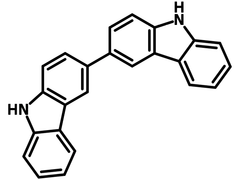3,3'-Bicarbazole
CAS Number 1984-49-2
Chemistry Building Blocks, Heterocyclic Building Blocks, Materials, Monomers
3,3'-Bicarbazole, Bicarbazole derivative
A useful building block for the synthesis of hole transport layer, host, TADF emitting layer materials in application of organic light-emitting devices and perovskite solar cells.
Specifications | MSDS | Literature and Reviews
3,3'-Bicarbazole (CAS number 1984-49-2) is a bicarbazole derivate that is formed by joining two carbazole units at 3,3'-positions. Bonding at 3,3'-positions not only extends the conjugation of each individual carbazole units but also improves the stability by partially blocking the electron active sites at 3,3'-positions.
As a bipolar charge transporting material derived from 3,3‘-bicarbazole, triphenylsilyl-substituted 3,3‘-bicarbazole, was found to be a good phosphorescent host that is competitive with the widely used host mCP. Warm-white-emissive device exploring 9-(9,9’-spirobi[fluoren]-3-yl)-9’-phenyl-9H,9’H-3,3’-bicarbazole (SFBCz) as one of the exciplex-forming hosts, a blue TADF-sensitizer 5TCzBN, and a yellow fluorescent dopant TBRb in a single-emissive-layer demonstrated an external quantum efficiency of 21.4%, a benchmark PE of 69.6 lm W-1, and a remarkable T80 of >8200 h at 1000 cd m-2.
Highly efficient and stable perovskite solar cells using the p–i–n device structure ITO/NiOx/NP-BC/perovskite/PCBM/BCP/Ag achieved an overall PCE of almost 20%. NP-BC is 3,3′-bicarbazole-based hole transporting material 9,9'-Diphenyl-9H,9'H-3,3'-bicarbazole, also named as BczPh.
Bicarbazole building block
for the synthesis of OLED and organic photovoltaic materials
Worldwide shipping
Quick and reliable shipping
With extended π-π conjugation
for high efficient photoluminescence
High purity
>98% Purity
General Information
| CAS Number | 1984-49-2 |
| Chemical Formula | C24H16N2 |
| Molecular Weight | 332.41 g/mol |
| Full Name | 3,3'-Bicarbazole |
| Synonyms | 9H,9'H-3,3'-Bicarbazole, 3,3'-Bi-9H-carbazole; 9H,9H-[3,3]Bicarbazolyl |
| Classification / Family | Bicarbazole derivatives, Semiconductor synthesis intermediates, Heterocyclic building blocks |
Chemical Structure

Product Details
| Purity | >98% (1H NMR) |
| Melting Point | N/A |
| Appearance | Off-white to grey powder/crystals |
MSDS Documentation
Literature and Reviews
-
3,3′-Bicarbazole-based compounds as bipolar hosts for green and red phosphorescent organic light-emitting devices, O. Bezvikonnyi et al., Mater. Sci. Eng. B, 261, 114662 (2020); DOI: 10.1016/j.mseb.2020.114662.
-
Forming a Metal-Free Oxidatively Coupled Agent, Bicarbazole, as a Defect Passivation for HTM and an Interfacial Layer in a p–i–n Perovskite Solar Cell Exhibits Nearly 20% Efficiency, S. Maddala et al., Chem. Mater., 32 (1), 127–138 (2020); DOI: 10.1021/acs.chemmater.9b02720.
-
A π–D and π–A Exciplex-Forming Host for High-Efficiency and Long-Lifetime Single-Emissive-Layer Fluorescent White Organic Light-Emitting Diodes, C. Zhang et al., Adv. Mater., 32 (42), 2004040 (2020); DOI: 10.1002/adma.202004040.

 3,3'-Bicarbazole MSDS Sheet
3,3'-Bicarbazole MSDS Sheet